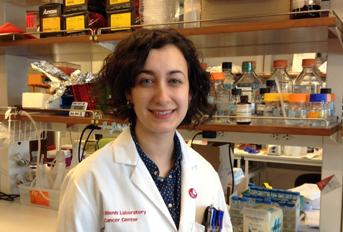Associação Portuguesa de Investigação em Cancro
A mitochondrial DNA mutation, causing mitochondrial oxidative phosphorylation deficiency, modifies cancer cells’ properties
A mitochondrial DNA mutation, causing mitochondrial oxidative phosphorylation deficiency, modifies cancer cells’ properties

A research group from Ipatimup discovered that, when a cancer cell harbours a deficiency in oxidative phosphorylation, this increases their ability to move and migrate, as well as their ability to form tumours and metastasis in mice. These effects seem to be mediated by a change in cell-matrix adhesion capacity.
This study, published in Human Molecular Genetics in December 2014, was made using cybrid cell lines, which are hybrid cells that combine the nucleus from one cell line with mitochondria from another. In this case, we have generated a cybrid cell line with a mitochondrial DNA mutation (causing the oxidative phosphorylation deficiency) and compared their behaviour with a cybrid cell line with normal mitochondrial DNA (with normal oxidative phosphorylation).
This study sheds new light into the metabolic mechanisms that regulate cancer cells’ motility and migration capacities.
Authors and Affiliations:
Nunes JB1, Peixoto J2, Soares P1, Maximo V1, Carvalho S2, Pinho SS2, Vieira AF2, Paredes J1, Rego AC3, Ferreira IL4, Gomez-Lazaro M5, Sobrinho-Simoes M6, Singh KK7, Lima J8.
1Institute of Molecular Pathology and Immunology of the University of Porto (IPATIMUP), Porto, Portugal, Medical Faculty and.
2Institute of Molecular Pathology and Immunology of the University of Porto (IPATIMUP), Porto, Portugal.
3Center for Neuroscience and Cell Biology (CNC) and Faculty of Medicine, University of Coimbra-Pólo III, 3000-354 Coimbra, Portugal, Institute for Interdisciplinary Research (IIIUC), University of Coimbra, 3030-789 Coimbra, Portugal.
4Center for Neuroscience and Cell Biology (CNC) and Institute for Interdisciplinary Research (IIIUC), University of Coimbra, 3030-789 Coimbra, Portugal.
5b.IMAGE-Bioimaging Centre for Biomaterials and Regenerative Therapies, Institute of Biomedical Engineering (INEB), University of Porto, Porto, Portugal.
6Institute of Molecular Pathology and Immunology of the University of Porto (IPATIMUP), Porto, Portugal, Medical Faculty and Centro Hospitalar de S. João, Porto, Portugal.
7Department of Genetics, Department of Pathology and Department of Environmental Health, Center for Free Radical Biology, Center for Aging and UAB Comprehensive Cancer Center, University of Alabama at Birmingham, Birmingham, Alabama and Birmingham Veterans Affairs Medical Center, Birmingham, AL 35294, USA.
8Institute of Molecular Pathology and Immunology of the University of Porto (IPATIMUP), Porto, Portugal, Medical Faculty and.
Abstract:
Mitochondria are central organelles for cellular metabolism. In cancer cells, mitochondrial oxidative phosphorylation (OXPHOS) dysfunction has been shown to promote migration, invasion, metastization and apoptosis resistance. With the purpose of analysing the effects of OXPHOS dysfunction in cancer cells and the molecular players involved, we generated cybrid cell lines harbouring either wild-type (WT) or mutant mitochondrial DNA (mtDNA) [tRNAmut cybrids, which harbour the pathogenic A3243T mutation in the leucine transfer RNA gene (tRNAleu)]. tRNAmut cybrids exhibited lower oxygen consumption and higher glucose consumption and lactate production than WT cybrids. tRNAmut cybrids displayed increased motility and migration capacities, which were associated with altered integrin-β1 N-glycosylation, in particular with higher levels of β-1,6-N-acetylglucosamine (GlcNAc) branched N-glycans. This integrin-β1 N-glycosylation pattern was correlated with higher levels of membrane-bound integrin-β1 and also with increased binding to fibronectin. When cultured in vitro, tRNAmut cybrids presented lower growth rate than WT cybrids, however, when injected in nude mice, tRNAmut cybrids produced larger tumours and showed higher metastatic potential than WT cybrids. We conclude that mtDNA-driven OXPHOS dysfunction correlates with increased motility and migration capacities, through a mechanism that may involve the cross talk between cancer cell mitochondria and the extracellular matrix.
Journal: Human Molecular Genetics
Link: http://hmg.oxfordjournals.org/content/early/2015/01/23/hmg.ddu612.long




